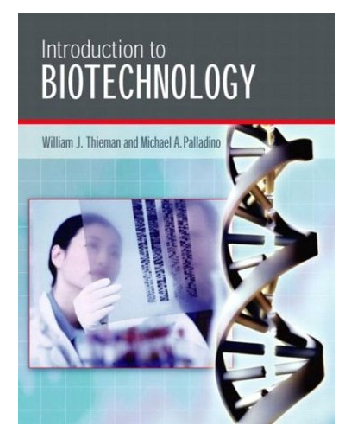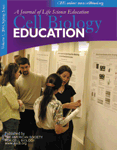Biology for the Utilitarian
Students enjoy learning about everyday applications of life science. I highlight these on the first day of Cell Biology 302 using the job search engine, Monster.com. By scrolling through the results of a “Cell Biologist” key-word search, students learn how cell biologists apply fundamental biological concepts to their careers. “Introduction to Biotechnology” begins the same way. Tucked behind the front cover is a colorful, pin-up poster that showcases numerous career opportunities for biotechnologists and includes the educational pre-requisites and salary ranges of each. The book itself also helps answer “what you can do with your biotechnology skills.” From a manufacturing technician holding a bachelor's degree in biology, to a bioethicist with a doctorate in philosophy, “Introduction to Biotechnology” is an excellent resource for anyone considering a career in this broad field.
CONTENT
This utilitarian theme is woven among the book's chapters, the first of which categorizes biotechnology into microbial, agricultural, animal, forensic, bioremediation, medical, aquatic and regulatory fields. In preparation for a more in-depth discussion of each field, Chapters 2, 3, and 4 review the fundamental principles of cell and molecular biology and the techniques of recombinant DNA, protein production and protein purification. The subsequent eight chapters characterize each of the eight individual fields using historical accounts, current and future applications, common molecular and biochemical techniques, environmental and ethical concerns, and career profiles. The 300-page book ends with a chapter on ethics that introduces Hippocrates and Kant before examining genetic engineering and the role that economics and science play in the evolution of our age-old biotechnology practices.
The reviews in Chapters 2, 3, and 4 are compressed into 80 pages and lack clarity, among other things. For example, a Chapter 2 statement that RNA polymerase “proceeds in a 5' to 3' direction along the DNA template strand to copy a complementary strand of RNA” is ambiguous because the relationship between coding information and the template strand is not explained. The neighboring statement that “chromosomes are formed during DNA replication only” is incorrect. In Figure 3.3, an attempt to diagram plasmid cloning fails when non-recombinant ampR, tetR bacteria are selected for amplication instead of the desired, recombinant ampR cells. The one-half page review of Protein Folding in Chapter 4 bravely tries to explain how hydrogen bonds stabilize α-helices and β-sheets without a sufficiently detailed diagram. These chapters will cause confusion among unfamiliar readers who would be better off using more comprehensive sources for review.

Chapters 5-12 described the eight fields of biotechnology. Historical accounts of each generally convey the benefits of biotechnology. Examples include recombinant human insulin production, Bt crops, the bioremediation powers of bacteria and the fertilizers that stimulate their decontaminating chores, and the successful treatment of the first human gene therapy patient. Attention is also paid to the government's regulatory framework that oversaw development and production. Informative statistics document most of these accounts:
74% of the soybean crop and 32% of the corn crop planted by American farmers in 2002 were genetically engineered to resist pests or herbicides;
Human tests are only performed with one out of every 1,000 potentially useful compounds;
Japan spends nearly $1 billion annually for research and development in aquatic biotechnology, while the United States spends less than $50 million;
By 2002, 20% of China's cotton acreage contained Bt varieties that reduced the cost of producing a kilogram of cotton by 28%.
Current and future applications are excellent in some fields but less so in others. I learned a tremendous amount about applications used in bioremediation, agriculture and aquaculture. For example, the latter employs triploid marine species to enhance the growth traits of fish and shellfish and is investigating the ocean's electric gradient (produced by plankton) for possible use as an energy source. Medical applications of biotechnology are also addressed and the sections on gene therapy and stem cell research are particularly good. However, a great deal of emphasis is placed on the impact that bioinformatics has on medical applications although it is not clarified how genome sequencing actually leads to the identification of genes.“ Understanding the genome of V. cholerae will help scientists identify toxin genes, genes for antibiotic resistance, and other genes that will augment our current methods for combating this microbe.” Unfortunately, the reader does not learn how the genome sequence of this organism can actually be used to find toxin genes. In addition, chemical genomics and its cutting-edge medical applications are not discussed, and only a brief mention of small molecular inhibitors exists. Thus, little attention is paid to current molecular methods of drug discovery that have revolutionized the pharmaceutical industry. Likewise, only a few sentences refer to antisense RNA, so its present and future medical impacts are not addressed.
Descriptions of common molecular and biochemical techniques are good. For example, diagrams clearly show how a cystic fibrosis patient can be treated with gene therapy, how DNA fingerprints for a murder case are produced, and how Flavr Savr™ transgenic tomatoes (an agricultural reference to antisense RNA) and transgenic fish that over-express growth hormones are developed.
Environmental and ethical concerns over applications of biotechnology are tackled, including what can go wrong when transgenic organisms are released into the environment. Triploid carp, which have a ravenous appetite for freshwater vegetation, were released into American waterways to control weed growth. Unfortunately, they consumed too much vegetation, causing water quality to drop and native fish to lose substantial amounts of habitat. Question and Answer boxes challenge readers to face the ethical questions posed by biotech advances. “Should reproductive cloning of humans be banned?” “Is routine collection of blood and the compilation of DNA databases a reasonable tool in the effort to fight crime or unwarranted invasion of privacy?” Keep in mind that guidelines for answering these questions do not appear until the last chapter, which will make it difficult to determine if the risk of an antibiotic gene passing from a plant to a bacterium is acceptable while you are reading Chapter 6.
Again, the career profiles are outstanding. And while the book contends that “career prospects in biotech are excellent,” and drug discovery is “a hot job market,” I was relieved to find the more candid view submitted by a recent graduate. “Gaining employment with a biopharmaceutical company is not easy. Competition is fierce.” I know many people who would tend to agree with Mr. Sexton's pragmatic view.
AUDIENCE
Readers can be as diverse as the eight different fields of biotechnology, and divided roughly into students and reference-seekers. Students are those interested in learning about the eight fields of biotechnology and understanding the science behind each. But remember that Chapters 2, 3, and 4 are intended to be quick reminders of, and not teaching tools for, DNA replication, transcription, translation and basic techniques of molecular biology and protein chemistry. Students should acquire an understanding of the central dogma and these basic life science skills elsewhere. Candidates include undergraduate juniors and seniors who are familiar with these topics.
The reference-seekers are those trying to relate just about any life science topic to a real world application. High school and undergraduate teachers can use it to show students that biotechnology contributes to their stone-washed jeans, clean contact lenses and any edible vaccines they may encounter in future cafeteria meals. People on both sides of the Genetically Modified Food protest line would likely benefit by reading the Plant Biotechnology portion that addresses both sides of the debate. Importantly, the book conveys an objective tone when addressing such volatile issues.
AESTHETICS
The photographs are black and white and the figures are typically black and white diagrams colored with different shades of red. The font of the figure legends was small and tedious to read.
EFFICACY
The book effectively discusses the nonmedically related applications of biotechnology, excelling in the areas of bioremediation, agriculture and aquaculture. Chapters on ethics and the regulatory procedures in America and abroad are also well done. Apart from the sections on gene therapy and stem cell research, the medically related applications fall short of cutting-edge. In conclusion, this is a good introduction to biotechnology that can be used as a reference source for high school and undergraduate teachers, one-credit hour seminar course material for undergraduate juniors and seniors, and career programs that prepare adults for entry-level biotech jobs.



